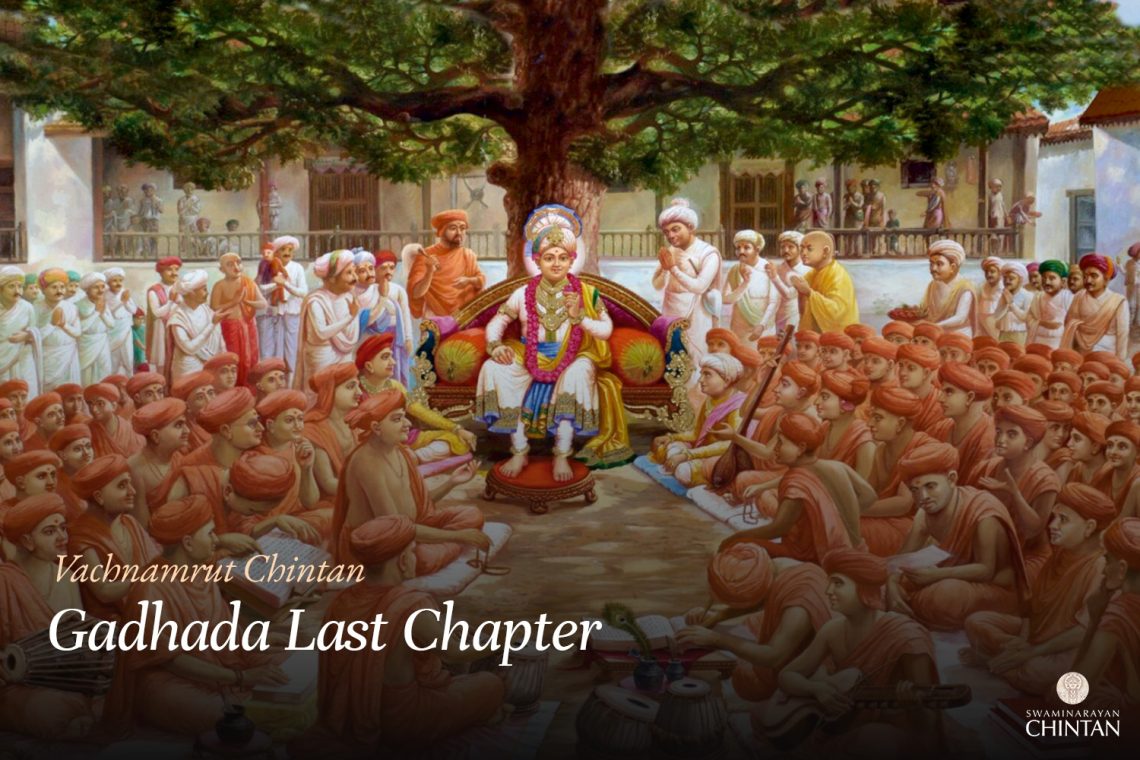Central Insights:
- The method to remain eternally happy.
Key Points:
- Control the senses through vairagya (non-attachment) and dharma (moral conduct).
- Cultivate love, friendship, and interest in devotees.
- Prevent estrangement or indifference toward devotees.
Explanation:
This Vachanamrut addresses the path to attaining eternal happiness. Shreeji Maharaj asked the assembly of Santo (saints), “What is the method for a devotee of God to always remain happy?” While the question is straightforward, Maharaj’s answer helps us understand the means to stay happy in Satsang (holy fellowship). Ordinarily, vairagya alone suffices for happiness. As Sadguru Nishkulanand Swami writes, “One with vairagya is like a diamond that no suffering can burn.” Additionally, steadfastness in dharma is essential for happiness. While satisfaction and other virtues contribute to happiness, Maharaj emphasizes that intense love, friendship, and association with God and His devotees are indispensable for making Satsang eternally blissful.
Those who wish to benefit from the greatness of Satsang and experience the supreme joy described in the scriptures must follow these methods outlined by Maharaj. So, what is the way to remain eternally happy in Satsang? Or more specifically, what kind of person experiences Satsang as always blissful?
In His response, Maharaj explains that a devotee must first possess firm vairagya and second, intense steadfastness in Swadharma (one’s prescribed duties). With these two qualities, one gains control over their senses and mind, enabling eternal happiness. Maharaj further states that one who cannot control their senses through vairagya and dharma will not find happiness anywhere. Even during devotion, if one’s senses are drawn toward worldly pleasures (vishay), they will feel intense suffering in their heart. Therefore, even in the company of God and His devotees, one may remain unhappy without these essential qualities. Hence, vairagya and dharma are crucial for attaining happiness.
Once these qualities are achieved, a devotee must develop intense love for God and His devotees, cultivate close friendship, and cherish their association. For such a person, Satsang becomes a source of joy. Without these qualities, even if one has vairagya and dharma, Satsang might appear burdensome rather than blissful.
Until one develops a genuine interest and love for the thoughts and virtues of God and His devotees, the joy of Satsang or God cannot manifest, even in the presence of vairagya and dharma. These two qualities prevent sorrow, but the true joy of God and Satsang arises only from love for God and His devotees. Attaining this joy requires immersing oneself in their thoughts. Even if one has vairagya and dharma, a lack of love for God and His devotees acts as a veil, depriving one of the bliss of Satsang. Conversely, if a devotee has immense love and friendship for God and His devotees but has not controlled their senses through vairagya and dharma, they will still not find happiness.
Later, Muktanand Swami asked, “Maharaj, what is the greatest obstacle for a devotee in their devotion to God?” To this, Maharaj replied, “The greatest obstacle for a devotee is their inability to recognize their own faults. When a devotee becomes estranged from God and His devotees, they develop indifference, which is the greatest hindrance.”
Devotion to God is not self-centered (svapradhan); rather, it is centered on God and His devotees (par-pradhan). If one maintains their humility and prioritizes God and His devotees, their devotion remains uninterrupted. However, if one clings to their own ego and self-importance, their devotion will dissolve and perish. Being virtuous is not an obstacle, but if self-centeredness overshadows devotion and diminishes respect for devotees, then devotion cannot survive. This, Maharaj asserts, is the greatest obstacle.
Glossary
| Vairagya – Detachment From Everything Except God |
| Dharma – Moral conduct |
| Satsang – Holy fellowship |
| Swadharma – One’s righteous duty The moral and spiritual obligations a person must follow according to their role in life. |
| Vishay – Objects of sensory pleasure Anything that engages the senses, leading to attraction or attachment. |
| Sadguru – True spiritual guide A realized saint who instills firm faith in Bhagwan’s form and guides seekers on the path of devotion. |
| Muktanand Swami – A Most Revered Saint of Bhagwan Swaminarayan A prominent Saint in Swaminarayan Sampraday, known for his deep devotion and wisdom. |
| Par-pradhan – Centered on God and His devotees A devotion that prioritizes God and His devotees over oneself, ensuring spiritual stability and progress. |
| Svapradhan – Self-centered A self-focused approach to devotion that can lead to estrangement and spiritual downfall. |
| Ego – Self-Respect & Self- Importance |
| Eternal Happiness – Lasting joy |

